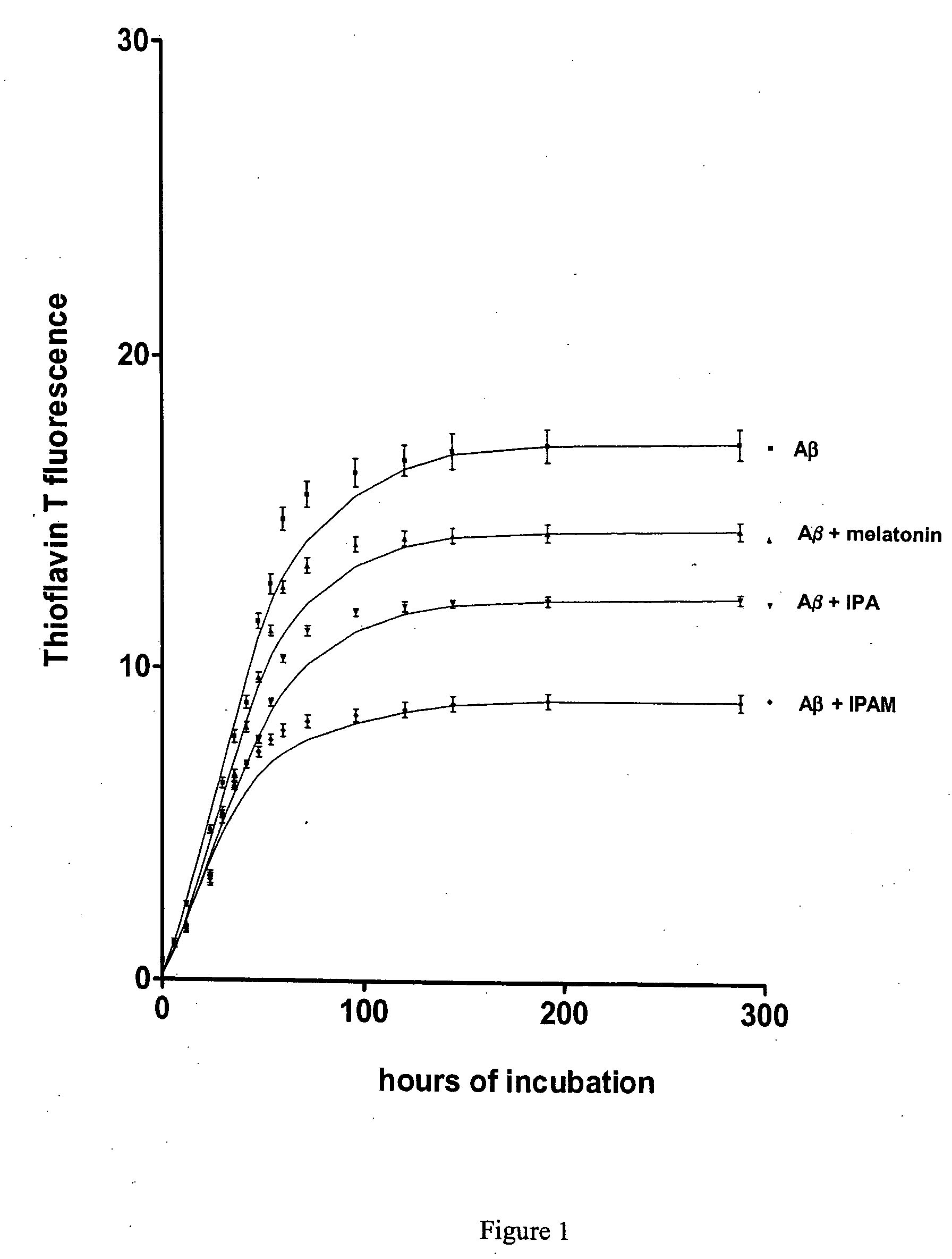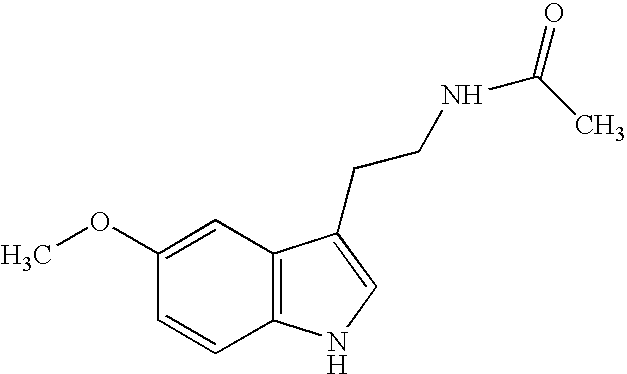Indole-3-propionamide and derivatives thereof
a technology of indole-3 propionamide and derivatives, which is applied in the direction of biocide, tetracycline active ingredients, heterocyclic compound active ingredients, etc., can solve the problems of poor penetration of blood brain barrier for ipa, and achieve extensive first pass effect, high synthesis efficiency, and high synthesis efficiency
- Summary
- Abstract
- Description
- Claims
- Application Information
AI Technical Summary
Benefits of technology
Problems solved by technology
Method used
Image
Examples
example 1
[0041] An important feature of IPAM, as compared to other neuroprotective indoles such as melatonin or indolepropionic acid is the combination of both, longer half life and lipophilic properties as demonstrated in the following example:
[0042] Time dependent changes in indole levels in brain tissue (pg / mg protein) after administration of 0.5 mg / kg i.p. of drug in phosphate buffered saline to one month old male Sprague-Dawley rats (N=4 animals, mean+SD). Endogenous levels of melatonin in saline treated control animals were 25+10 pg / mg protein, endogenous levels of indolepropionate were 80+20 pg / mg protein. Significant amounts of endogenous IPAM in rat brain could not be detected. Brain tissue was homogenized 1:10 in phosphate buffer and extracted 1:1 with ethylacetate. Recovery for melatonin, indolepropionate and IPAM were 57+6, 69+12 and 80+4%. Indoles were measured by HPLC with electrochemical detection (20% methanol eluent, 990 mV oxidation potential, IPAM elutes at 18 minutes, me...
example 2
Inhibition of Hydroxyl Radical Mediated Oxidative Damage to DNA By IPAM in Rat Forebrain Homogenate
[0043] Rat forebrain homogenate was incubated for sixty minutes with 3 mM hydrogen peroxide, 4 mM ferrous sulfate and 2 mM ADP to generate hydroxyl radicals. The concentrations of each indole compound to reduce oxidative DNA damage by 50%, the IC 50 values, are given as means+standard deviations for N=6 different determinations. The IC 50 values were calculated by running six experiments each at 10 increasing concentrations ranging from 0.01 to 100 micromolar of melatonin, indole-3-propionic acid and indole-3-propionamide. DNA damage was examined by measuring the formation of 8-hydroxydeoxyguanosine with HPLC and electrochemical detection in the presence and absence of the hydroxyl radical scavengers.
TreatmentIC 50Melatonin1.40 + 0.16 μMIndole-3-propionic acid7.46 + 0.80 μMIPAM0.18 + 0.03 μM
example 3
Inhibition of the Aging Process in a Rotifer Model (Philodina) By Melatonin, Indolepropionate and IPAM
[0044] Free-radicals are involved in the aging process and since IPAM is a powerful cytoprotective agent, we tested IPAM for its property to inhibit the aging process. The following experiments illustrate that not only was IPAM devoid of toxicity, but it dramatically extended the life span of rotifers, an established model of aging. The potency of IPAM exceeded that of melatonin and IPA and was far superior to any other compound thus far described in the literature. (*=p<0.05, statistically significant difference to control).
Median lifeMaximum lifespan in daysIncrease in %span in daysIncrease in %Treatment(50% survival)of control(90% survival)of controlControl (0.1% DMSO)23.4 +− 0.6270.5 μM melatonin28.0 +− 1.5+19%(N.S.)35+30%0.5 μM30.0 +− 1.7+28%(*)39+37%indolpropionic acid0.5 μM IPAM31.8 +− 1.7+31%(*)42+55%Control (0.1% DMSO)25.9 +− 0.8305 μM melatonin33.5 +− 1.5+29%(*)42+40%5 ...
PUM
| Property | Measurement | Unit |
|---|---|---|
| Area | aaaaa | aaaaa |
| Disorder | aaaaa | aaaaa |
Abstract
Description
Claims
Application Information
 Login to View More
Login to View More - R&D
- Intellectual Property
- Life Sciences
- Materials
- Tech Scout
- Unparalleled Data Quality
- Higher Quality Content
- 60% Fewer Hallucinations
Browse by: Latest US Patents, China's latest patents, Technical Efficacy Thesaurus, Application Domain, Technology Topic, Popular Technical Reports.
© 2025 PatSnap. All rights reserved.Legal|Privacy policy|Modern Slavery Act Transparency Statement|Sitemap|About US| Contact US: help@patsnap.com



